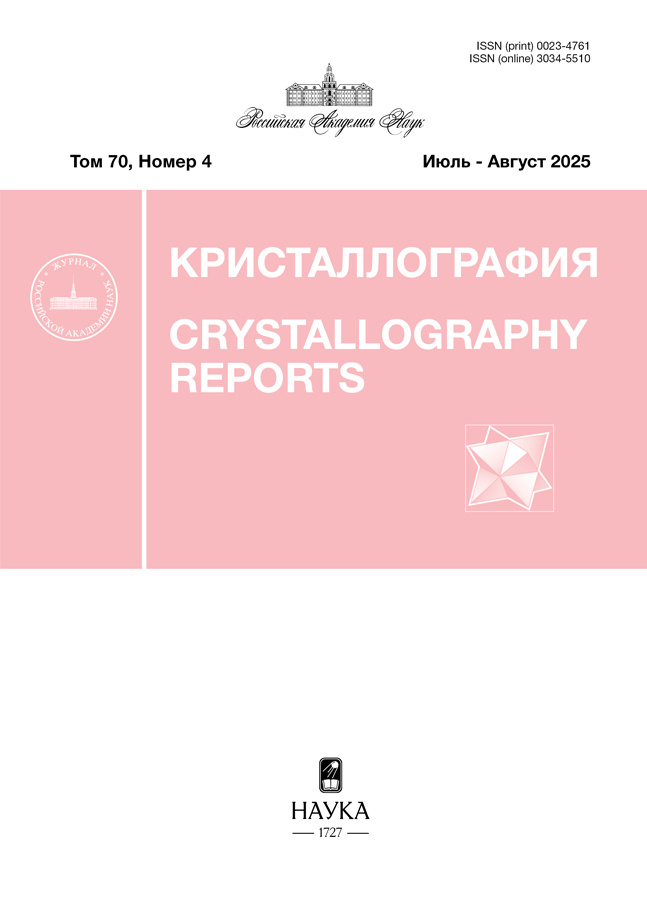Microstructural changes in magnesium alloy Mg-Zn-REE after irradiation with nanosecond laser pulses
- Authors: Vasiliev A.L.1,2,3, Krishtal M.M.2, Grigoriev Y.V.1, Polunin A.V.2, Rodin A.O.4, Kolobov Y.R.2,5
-
Affiliations:
- National Research Center “Kurchatov Institute”
- Togliatti State University
- Moscow Institute of Physics and Technology (National Research University)
- National University of Science and Technology MISIS
- Federal Research Center of Problems of Chemical Physics and Medicinal Chemistry of the Russian Academy of Sciences
- Issue: Vol 70, No 4 (2025)
- Pages: 705–712
- Section: ПОВЕРХНОСТЬ, ТОНКИЕ ПЛЕНКИ
- URL: https://clinpractice.ru/0023-4761/article/view/688097
- DOI: https://doi.org/10.31857/S0023476125040215
- EDN: https://elibrary.ru/JIGPSU
- ID: 688097
Cite item
Abstract
The article presents the results of studies of the structure and composition of the surface and near-surface layers of the Mg–Y–Zn–Nd–Yb–Zr alloy system with a long-period phase after irradiation with nanosecond laser pulses using electron microscopy and energy-dispersive X-ray microanalysis. It is shown that in a two-phase alloy, a layer of nanocrystalline MgO with a thickness from 5 nm to hundreds of nm is formed on the surface in the α-Mg matrix region. A recrystallized layer of columnar crystallites with a thickness of about 1 μm and a lateral size of 0.2–1 μm with inclusions of cubic MgO is formed under it. In the area of the intermetallic compound (phase Mg12YZn–REE type 18R), a three-layer amorphous-crystalline structure is formed: an amorphous layer 15–20 nm thick on the surface, under it a crystalline layer of columnar crystallites 0.1–0.3 μm thick and with lateral dimensions of 0.1–0.5 μm, then an amorphous layer of intermetallic compound about 1 μm thick.
Full Text
About the authors
A. L. Vasiliev
National Research Center “Kurchatov Institute”; Togliatti State University; Moscow Institute of Physics and Technology (National Research University)
Author for correspondence.
Email: a.vasiliev56@gmail.com
Russian Federation, Moscow; Togliatti; Dolgoprudny
M. M. Krishtal
Togliatti State University
Email: a.vasiliev56@gmail.com
Russian Federation, Togliatti
Yu. V. Grigoriev
National Research Center “Kurchatov Institute”
Email: a.vasiliev56@gmail.com
Russian Federation, Moscow
A. V. Polunin
Togliatti State University
Email: a.vasiliev56@gmail.com
Russian Federation, Togliatti
A. O. Rodin
National University of Science and Technology MISIS
Email: a.vasiliev56@gmail.com
Russian Federation, Moscow
Yu. R. Kolobov
Togliatti State University; Federal Research Center of Problems of Chemical Physics and Medicinal Chemistry of the Russian Academy of Sciences
Email: a.vasiliev56@gmail.com
Russian Federation, Togliatti; Chernogolovka, Moscow Region
References
- Фролов К.В. Машиностроение: энциклопедия. Т. II-3. Цветные металлы и сплавы. Композиционные металлические материалы. М.: Машиностроение, 2001. 879 c.
- Альтман М.Б., Антипова А.П., Блохина А.П. и др. Металловедение магния и его сплавов. Области применения. М.: Металлургия, 1978. Т. 2. 237 c.
- Петров А.А., Сперанский К.А. // Тр. ВИАМ. 2021. № 10 (104). С. 12. https://doi.org/10.18577/2307-6046-2021-0-10-12-27
- Мостяев И.В. // Тр. ВИАМ. 2015. № 7. С. 8. https://doi.org/10.18577/2307-6046-2015-0-7-3-3
- Фролов А.В., Мухина И.Ю., Леонов А. А. и др. // Тр. ВИАМ. 2016. № 3 (39). С. 23. https://doi.org/10.18577/2307-6046-2016-0-3-3-3
- Поповски Ю., Папиров И.И., Шокуров В.С. и др. Патент RU2418878C2. Магниевый сплав с улучшенным сочетанием механических и коррозионных характеристик. 2010.
- Лукьянова Е.А. Дис. “Исследование магниевых сплавов с редкоземельными металлами для создания новых легких конструкционных материалов”… канд. тех. наук. М.: ИМЕТ РАН, 2014.
- Arun K.S., Rajesh R.J., Jithu K.G. et al. // J. Mater. Eng. Perform. 2022. V. 32. P. 2840. https://doi.org/10.1007/s11665-022-07213-5
- Jiang P., Blawert C., Zheludkevich M.L. // Corros. Mater. Degrad. 2020. V. 1. P. 92. https://doi.org/10.3390/cmd1010007
- Yamasaki M., Hayashi N., Izumi S., Kawamura Y. // Corrosion Sci. 2009. V. 49. P. 255. https://doi.org/10.1016/j.corsci.2006.05.017
- Wan D., Sun Y., Xue Y. et al. // China Foundry. 2024. V. 21. № 11. P. 634. https://doi.org/10.1007/s41230-024-3174-y
- Abdel Gawad M., Usman C.A., Shunmugasamy V.C. et al. // J. Magnes. Alloy. 2022. V. 10. № 6. P. 1542. https://doi.org/10.1016/j.jma.2021.11.025
- Li C.Q., Xu D.K., Zeng Z.R. et al. // Mater. Des. 2017. V. 121. P. 430. https://doi.org/10.1016/j.matdes.2017.02.078
- Pałgan D., Dobkowska A., Zielińska A. et al. // Crystals. 2022. V. 12. P. 1723. https://doi.org/10.3390/cryst12121723
- Wang Y., Zhang Y., Wang P. et al. // J. Mater. Res. Technol. 2020. V. 9. № 3. P. 7087. https://doi.org/10.1016/j.jmrt.2020.05.048
- Zhang S., Jiang J., Zou X. et al. // Front. Chem. 2022. V. 10. P. 1. https://doi.org/10.3389/fchem.2022.999630
- Wu S., Huang J., Fang J. et al. // Surf. Coat. Technol. 2023. V. 470. Р. 129870. https://doi.org/10.1016/j.surfcoat.2023.129870
- Li L., Yan D., Zou T. et al. // J. Alloys Compd. 2024. V. 1004. P. 175728. https://doi.org/10.1016/j.jallcom.2024.175728
- Божко С.А., Манохин С.С., Колобова Е.Г., Колобов Ю.Р. Патент RU 2691154 C1. Способ формирования коррозионно-устойчивого слоя на поверхности магниевых деформируемых сплавов. 11.06.2019.
- Cheretaeva A.O., Glukhov P.A., Shafeev M.R. et al. // Chimica Techno Acta. 2023. V. 10. № 2. 202310212. https://doi.org/10.15826/chimtech.2023.10.2.12
- Schimmel H.G., Huot J., Chapon L.C. et al. // J. Am. Chem. Soc. 2005. V. 127. № 41. P. 14348. https://doi.org/10.1021/ja051508a
- Tsirel'son V.G., Avilov A.S., Abramov et al. // Acta Cryst. B. 1998. V. 54. P. 8. https://doi.org/10.1107/S0108768197008963
- Itoi T., Seimiya T., Kawamura Y., Hirohashi M. // Scripta Mater. 2004. V. 51. № 2. Р. 107. https://doi.org/10.1016/j.scriptamat.2004.04.003
- Петров А.А., Сперанский К.А. // Тр. ВИАМ. 2021. № 11 (105). С. 12. https://doi.org/10.18577/2307-6046-2021-0-11-12-24
- Li X.Y., Guo Y.F., Mao Y. et al. // Int. J. Plast. 2022. V. 158. P. 103437. https://doi.org/10.1016/j.ijplas.2022.103437
- Zhao S., Xu Y., Lin X. et al. // J. Mater. Res. Technol. 2022. V. 18. P. 461. https://doi.org/10.1016/j.jmrt.2022.02.066
- Malik A., Yangwei W., Huanwu C. et al. // Vacuum. 2019. V. 168. P. 108810. https://doi.org/10.1016/j.vacuum.2019.108810
- Malik A., Yangwei W., Huanwu C. et al. // J. Mater. Res. Technol. 2019. V. 8. P. 3475. https://doi.org/10.1016/j.jmrt.2019.06.018
- Busk R.S. // JOM. 1950. V. 2. P. 1460. https://doi.org/10.1007/BF03399173
Supplementary files

















